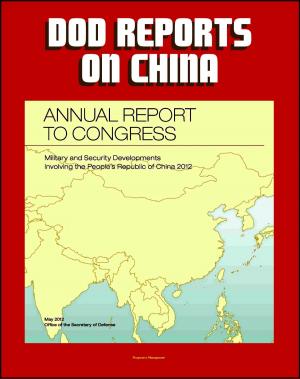Oral Histories of Ballistic Missile Development Pioneers from the NASA Oral History Project: Featuring Simon Ramo, Co-founder of TRW, and General Bernard A. Schriever, USAF Missile Architect
Nonfiction, History, Military, Nuclear Warfare, Science & Nature, Technology, Aeronautics & Astronautics| Author: | Progressive Management | ISBN: | 9780463303191 |
| Publisher: | Progressive Management | Publication: | May 20, 2018 |
| Imprint: | Smashwords Edition | Language: | English |
| Author: | Progressive Management |
| ISBN: | 9780463303191 |
| Publisher: | Progressive Management |
| Publication: | May 20, 2018 |
| Imprint: | Smashwords Edition |
| Language: | English |
As part of the NASA Oral History Project, three key figures in the development of ballistic missiles were interviewed: Ruben F. Mettler, Ballistic Missile Engineer; Simon Ramo, Chairman and CEO, TRW, Inc.; Co-founder TRW, Inc. (primary contractor to U.S. Air Force for ballistic missiles); and famous General Bernard A. Schriever, Commander, U.S. Air Force Western Development/ Ballistic Missile Division.
Mettler said: It was very clear to everybody that if you could achieve a 6,000-mile ballistic missile, a little more velocity would miss the Earth on the other side and, hence, go into orbit. So it was very clear that a 6,000-mile ICBM, if the payload was reduced or if an additional stage was added, could, without any doubt, be a launcher for a satellite. I used to try to explain that by saying, well, now, [Isaac] Newton, in the seventeenth century—I guess it was seventeenth, yes—had the analogy that if you imagined that there was a tower that was twenty miles high, you threw a rock out, it would land. You threw it a little harder, it would go farther. If you threw it hard enough, it would go around and hit you in the back of your head. So there was no mystery about the fact that some additional velocity and additional technology could become the launcher for satellites and for space. There was no question that Sputnik changed the attitudes and a number of the decisions in the Defense Department and really all the way up to the President, President [Dwight D.] Eisenhower, because it was a demonstration that they then, the Soviets, if you recall, then tried to advertise as a rationale for having a superior economic system, and this propaganda, what it really was, was quite effective and surprised and affected many people around the world.
There's no question that it stimulated the urgency, and schedules were shortened. I can recall clearly one trip that General Schriever made to Washington at that time. He came back and he said, "Your schedule is now one year earlier than it was," and that went through the whole program. Also it was one of the rationales for the IRBM. It was clearly an easier problem to do a 2,000-mile ballistic missile than a 6,000 mile. The idea was that an early, quick, really very crash program for a short-range weapon could then, in emergency, be deployed forward in England or Italy, even Turkey, if necessary. So Sputnik was an accelerator. It was a catalyst, maybe is the best way to say it.
As part of the NASA Oral History Project, three key figures in the development of ballistic missiles were interviewed: Ruben F. Mettler, Ballistic Missile Engineer; Simon Ramo, Chairman and CEO, TRW, Inc.; Co-founder TRW, Inc. (primary contractor to U.S. Air Force for ballistic missiles); and famous General Bernard A. Schriever, Commander, U.S. Air Force Western Development/ Ballistic Missile Division.
Mettler said: It was very clear to everybody that if you could achieve a 6,000-mile ballistic missile, a little more velocity would miss the Earth on the other side and, hence, go into orbit. So it was very clear that a 6,000-mile ICBM, if the payload was reduced or if an additional stage was added, could, without any doubt, be a launcher for a satellite. I used to try to explain that by saying, well, now, [Isaac] Newton, in the seventeenth century—I guess it was seventeenth, yes—had the analogy that if you imagined that there was a tower that was twenty miles high, you threw a rock out, it would land. You threw it a little harder, it would go farther. If you threw it hard enough, it would go around and hit you in the back of your head. So there was no mystery about the fact that some additional velocity and additional technology could become the launcher for satellites and for space. There was no question that Sputnik changed the attitudes and a number of the decisions in the Defense Department and really all the way up to the President, President [Dwight D.] Eisenhower, because it was a demonstration that they then, the Soviets, if you recall, then tried to advertise as a rationale for having a superior economic system, and this propaganda, what it really was, was quite effective and surprised and affected many people around the world.
There's no question that it stimulated the urgency, and schedules were shortened. I can recall clearly one trip that General Schriever made to Washington at that time. He came back and he said, "Your schedule is now one year earlier than it was," and that went through the whole program. Also it was one of the rationales for the IRBM. It was clearly an easier problem to do a 2,000-mile ballistic missile than a 6,000 mile. The idea was that an early, quick, really very crash program for a short-range weapon could then, in emergency, be deployed forward in England or Italy, even Turkey, if necessary. So Sputnik was an accelerator. It was a catalyst, maybe is the best way to say it.















